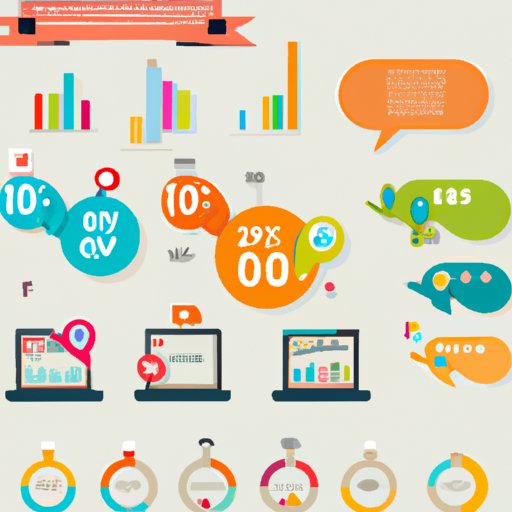
I. Introduction
Infographics are powerful tools used to communicate complex data and ideas in a visually appealing and easy-to-understand format. They can be used for various purposes such as promoting a product, analyzing trends, and telling a story. However, creating an infographic can be daunting, especially for those who don’t have a design background. This article aims to provide a step-by-step guide to designing effective infographics with a focus on key design elements, social media optimization, and tools available.
II. Step-by-Step Guide
Making an infographic can be tackled with the help of a step-by-step guide which includes the following:
- Choose the right software – There are a variety of tools available for creating infographics ranging from free options like Canva and Piktochart to paid options like Adobe Illustrator and InDesign. Research and select the best option for your needs and skill level.
- Design the layout – Start your design process with a rough sketch of your infographic’s overall structure. Divide the layout into sections and sub-sections, making sure to include clear headings and labels.
- Select the right colors – Choose a color scheme that suits your purpose. Take into account your branding or the message you want to communicate. Avoid using too many colors or not enough contrast between colors.
- Add data – Infographics communicate important data to its audience. The creation process should focus on finding the best way to represent this data within the design. Use visual aids such as charts, graphs, illustrations, photos, and icons to illustrate your data.
- Finalize your design – Once you have added all your data points, review your design to ensure consistency in your design choices. Preview your infographic with a test-audience to ensure it delivers the intended message.
III. Design Elements
Infographic design is more than just placing data into a visually appealing layout. It involves using design elements to communicate a message in a clear, concise, and engaging way. Below are some key design elements for creating a successful infographic:
- Color – Use contrasting colors to provide a sense of visual hierarchy and highlight important data. Colors should also convey the intended mood and tone.
- Typography – Choose a font that is easy to read and aligns with the style of your infographic. Use different font sizes and styles to create visual hierarchy and direct the viewer’s attention.
- Composition – The composition refers to the arrangement of elements in your infographic. Use shapes, lines, spacing, and symmetry to create a balanced and harmonious design.
- Imagery – Images such as charts, graphs, illustrations, and icons help visualize important data points and break up the text in your design.
IV. Infographics for Social Media
Designing an infographic optimized for social media involves understanding the strengths and limitations of various platforms. Below are some tips for designing infographics for popular platforms:
- Instagram – Use a vertical layout and bright colors to grab attention. Remember to keep your design simple and focused on a single message.
- Facebook – Use a square layout and bright colors to optimize for the newsfeed. Use visuals like charts, statistics, and images to convey your message.
- Pinterest – Use a vertical layout and appealing graphics with a strong headline to capture interest. Adding a watermark of your brand or website can help with brand recognition and drive traffic to your website.
V. Tools for Creating Infographics
There are a variety of software and tools available for creating infographics. Below is a list of popular options for both free and paid choices:
- Canva – free or paid with optional upgrade.
- Piktochart – free or paid with optional upgrade.
- Venngage – offers a free version with more upgrades.
- Adobe Illustrator – paid and part of the Creative Cloud Suite.
- Adobe InDesign – paid and part of the Creative Cloud Suite.
VI. Examples of Successful Infographics
There are many examples of successful infographics that define design choices and push boundaries. Below are some examples of successful infographics in different industries:
- The Most Expensive Homes in America – Forbes
- The Anatomy of Work Boot – Red Wing Shoes
- How Much Does Your State Invests in Education vs. Incarceration? – Daily Infographic
- The Ultimate Guide to Safer Sex – Visual.ly
VII. The Science of Infographics
Infographics work better than other forms of content because they engage the viewer, captivate their attention, and make the information easy to remember. The use of visual aids also triggers certain cognitive and psychological processes in the viewer. Below are some theories behind the effectiveness of infographics:
- The Picture Superiority Effect – images are remembered better than plain text.
- The Dual Coding Theory – when verbal and visual information are presented together, they are better retained.
- The Gestalt Theory – people perceive parts of a whole in a cohesive manner.
VIII. Conclusion
Infographics are a powerful tool when it comes to communicating information both internally and externally. The creation process should rely on research, design elements, and an understanding of social media platforms. Through design and data, infographics have the power to connect with audiences by breaking up complex concepts and providing them with easily digestible information. With the right tools and an understanding of successful examples, designing effective infographics is achievable, and the tools and information provided in this article will enable you to start creating with more confidence.




